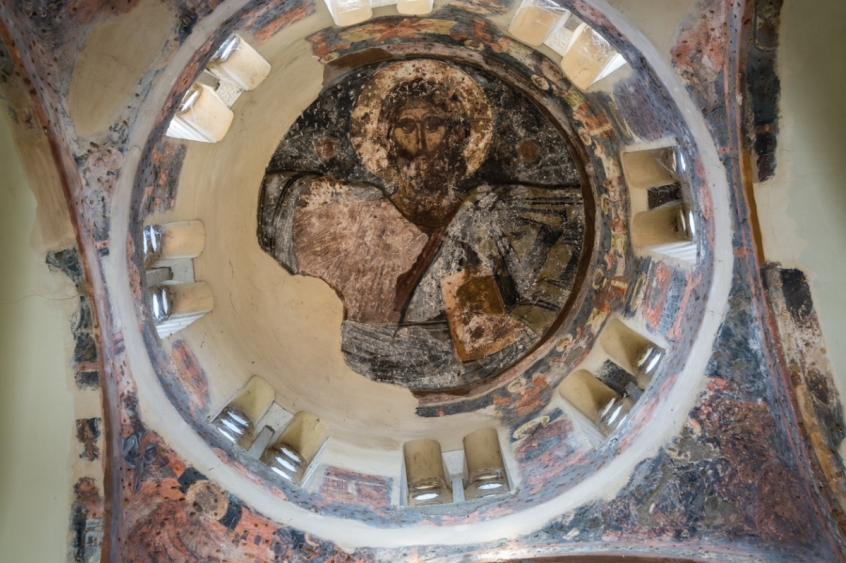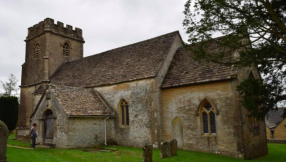
The writer of the Letter to the Hebrews reminds Christians that they are surrounded by a great "cloud of witnesses." (NRSV) That "cloud" has continued to grow in size since then. In this monthly column we will be thinking about some of the people and events, over the past 2000 years, that have helped make up this "cloud." People and events that have helped build the community of the Christian Church as it exists today.
Something quite remarkable happened in the middle of what we now call the first century AD. A small – but growing – sect of Judaism, originally centred on Jerusalem, began to declare that a Jewish preacher and worker of miracles, named Jesus, who had been condemned by their own religious authorities and finally executed by the Roman occupying power, had risen from the dead.
This, on its own, was dramatic, controversial, and shocking; but what was even more astonishing was that this group were honouring him in ways that had previously only been reserved for the one true God. In Jesus, they claimed the God of Israel had revealed himself in human form and, furthermore, it was only possible to gain salvation by belief in this anointed one – the "Christ" – who had died for our sins, been raised again to life, and ascended to the right hand of God the Father.
Questions, questions ...
This raised a lot of questions. In what sense did Christ have the nature of God and did this imply equality with or subservience to God? Did the man Jesus become "Christ" at a key moment within his life? His baptism was referred to by some Christian thinkers in this way; but the very idea of such an "adoption" was strongly rejected by the mainstream. Did he have an existence prior to his earthly birth? And if he did, was this an existence from eternity, or was he the exalted "First" among all that was created? In short: did he have a beginning or not?
Then there were so many questions relating to the way in which humanity and divinity were combined in Christ. Were these natures in some way distinct? Or were they inextricably mingled? Was humanity taken on by Christ, the Son of God, in such a way that he suffered pain and discomfort? But how can God – who is beyond such earthly limitations – experience such things? Or did Christ only appear to suffer? And what about the mind of Christ? Did Jesus know everything because he was God? Or were there limitations to his knowledge and he was reliant on God for his understanding? And if so, in what sense was he God? For God's knowledge is unlimited.
Such questions were – and are – not easily answered. A dynamic and radical religious community was soon exploring uncharted territory of faith and belief. These arguments were much more than just matters of intellectual curiosity. Christology (the study of Christ's nature) would have a direct impact on salvation. For, since salvation was dependent on Christ, who he was and what he was became a matter of life and death. This was very deep water indeed. And for some it soon became extremely hot water too that they found themselves in.
The New Testament belief that "the Word became flesh" (John 1:14) was, and is, a truly mind-blowing claim. Christians can either decide this expresses mysteries too deep to fathom or, alternatively, grapple with trying to analyse exactly what this means in terms of the nature of Christ and God. In the Late Roman Empire, they grappled.
Getting it 'right', getting it 'wrong'
These divisive debates would discuss such profound doctrines as that of the Trinity and the meaning of Christology. The very nature of God would be debated and defined as never before. The great Church Councils convened to address these debates would include those at Nicaea (325), Constantinople (381), Ephesus (431) and Chalcedon (451) which were regarded as "ecumenical" (world-wide) councils, whose decisions were binding on the whole Christian Church.
These great debates were to decide the nature of Christian understanding concerning the nature of Christ and God in a way that is difficult to exaggerate. Even in the more fragmented and disparate world of the twenty first century Church, the creeds produced at them still decide the shape of Christian debate. These early discussions started with the question of who exactly was, and is, the man declared to be Christ.
The arguments started early, as ideas were promoted by some on the edge of mainstream belief. There were many and these are just a sample. Saturninus of Antioch (early second century) held that Christ had no material existence; he only appeared to be human.
Others also subscribed to this belief in docetism (from the Greek 'to seem') in various forms. In contrast, Cerinthus, in late first century Ephesus, taught that Jesus really was a man but that the exalted "Christ" descended but then left him before the crucifixion.
Marcion of Sinope taught (c.144) the dualistic belief that the God of the Old Testament was a demiurge (creator of the material world), whereas Christ revealed a higher supreme God. He also taught that Christ was not born from Mary; instead, he appeared as a grown man. Similarly, he argued that the suffering of Christ was apparent, not real.
Ebionites believed that, as the human son of Joseph and Mary, Jesus was chosen by God at his baptism when he was anointed with the Holy Spirit. This adoptionist understanding would appear in other schools of thought too.
Arguably, of greater influence were the ideas associated with Arius, who lived in what is today Egypt, and which first came to prominence in about 318. In that year Arius was in conflict with the Bishop of Alexandria over his claim that only the Father was truly God. In contrast, Arius argued, Christ though highly exalted did not possess of himself the nature of God. He was brought into being ("begotten") by the Father (before his earthly birth) and before that event of being begotten did not exist. It was, nevertheless, through Christ the Son that God the Father created the world.
This left Christ with a position far exalted above the rest of creation but well below that of God the Father. Others countered with the view – which became the mainstream answer – that the scriptural idea of the "begotten Son" represented an eternal relationship, not a moment of birth or start of existence. This soon became something of a battleground. And from this the historic creeds emerged. What follows is a very simplified version of what was an extremely complex – theological and linguistic – debate.
A quick tour of the 'creed battleground' in the late Roman Empire
Arius was excommunicated but the matter did not end there. As the controversy drew in more Church leaders, and increased in intensity, the new emperor of a united East and West Roman Empire, Constantine I (the Great) called a council at Nicaea. This decided against Arius and produced a statement known as the Creed of Nicaea (325). A later creed, with similar content, is known as the Nicene Creed and is generally accepted across Christian churches.
The Creed of Nicaea encapsulated much of core Christian beliefs about Christ:
"Begotten from the Father, only-begotten, that is, from the substance of the Father, God
from God, light from light, true God from true God, begotten not made, of one substance
with the Father, through Whom all things came into being..."
The matter seemed settled, and the understanding was expressed in some technical Greek terms. God the Son (ie Christ) and God the Father were of the "same substance." Even after Nicaea, though, there were those who worried that the term might not be quite precise enough. After all, the word was in everyday use to describe two separate objects made from the same substance. This was clearly not the way it was used at Nicaea but others might interpret it this way. And, of course, some did.
Arianism continued to have a wide following in the East. A further boost to Arianism came when the barbarian Visigoths converted to an Arian form of Christianity and took it with them as they invaded the Western Roman Empire.
More moderate forms of Arianism were also apparent. In 362 a major synod held in Alexandria finally decided broadly in favour of Nicaea. Describing God as being recognisably "three persons" did not constitute belief in anything like three Gods. They did not have separate natures and were not separate beings. Instead, they possessed a single and uniting essence. But then the Eastern Roman Emperor Valens (ruled 364–78) declared in favour of the Arian outlook (as had his predecessor Emperor Constantius). The followers of Nicaea suddenly found themselves in conflict with the imperial authorities. For a moment it looked as if the Christian Church was becoming Arian.
In time, though, the crisis was averted by the actions of Basil the Great, the bishop of Caesarea in Cappadocia (in modern Turkey). Under his influence it became generally accepted in the Eastern Roman Empire that one could believe in both the united "substance" of God and that God existed in three recognisable but inseparable 'persons'.
This became widespread when supported by the new Eastern Roman Emperor Theodosius (ruled 379–395). Under his rule the whole Roman Empire was again briefly reunited. In 381 he summoned the Council of Constantinople, and it was at this council (according to a fifth-century tradition) that the Creed of Nicaea was re-launched (in a modified form) as the Nicene Creed. The age of Arianism was finally over.
The position of Christ and the belief in the Trinity had been largely settled in a manner that would define the future outlook of the Christian Church. There would, though, remain areas of contention. In the Western Church it became accepted that the Holy Spirit proceeded from the Father and the Son. In the Eastern Church the established view remained that the Holy Spirit proceeded from the Father, through the Son. The "filioque (Latin 'and from the Son') clause" continues to divide the Eastern and Western Church. This was a division impacting on the doctrine of the Trinity but the fundamental outlook on the nature of Christ and his relationship with God the Father was not disputed. There at least there was, finally, some unity.
After ferocious debate the full divinity of Christ had become a mainstream belief. But what of his humanity? If Christ was not fully human, as well as fully God, then his mental and emotional life, his ability to experience sorrow for example, would not be truly human. The Incarnation would lose its intimacy and its bridging of divine and human existence. Christ would simply have inhabited a human body. This reminds us that, while these complex arguments can easily appear arcane and rather obsessively detailed to us, they were extremely important.
The matter was not fully officially settled until the Council of Chalcedon in 451. The Chalcedonian Definition asserted that Christ was "...truly God and the same truly man...like us in all things apart from sin..." Even so, the so-called "Oriental Orthodox churches" were not reconciled on aspects of this subject with the Roman Catholic Church, the major Protestant churches, and the Eastern Orthodox Church until the second half of the twentieth century.
More than an intellectual debate
These debates were crucial in the history of Christianity because they have framed Christian understanding and discussion ever since. However, in the seventh century these disputes over doctrine also had social and political – as well as theological – ramifications. They added to the difficulties facing the Eastern Roman Empire in mounting a united defence against Muslim invasion.
Dissenting Christians, facing persecution from imperial authorities over these beliefs, were less inclined to defend the imperial system. Some even initially welcomed Islamic rule as a respite from imperial sanctions against them. Debates about the nature of Christ – coupled with how dissenters were treated by orthodox authorities – had unforeseen political consequences.
Martyn Whittock is an evangelical historian and a Licensed Lay Minister in the Church of England. As an historian and author, or co-author, of fifty-five books, his work covers a wide range of historical and theological themes. In addition, as a commentator and columnist, he has written for several print and online news platforms; has been interviewed on TV and radio shows exploring the interaction of faith and politics; and appeared on Sky News discussing political events in the USA. Recently, he has been interviewed on several news platforms concerning faith and the Crown in the UK, and the war in Ukraine. His co-written book, Christ The First 2000 Years (2016), explores the history of ideas about Christ.













